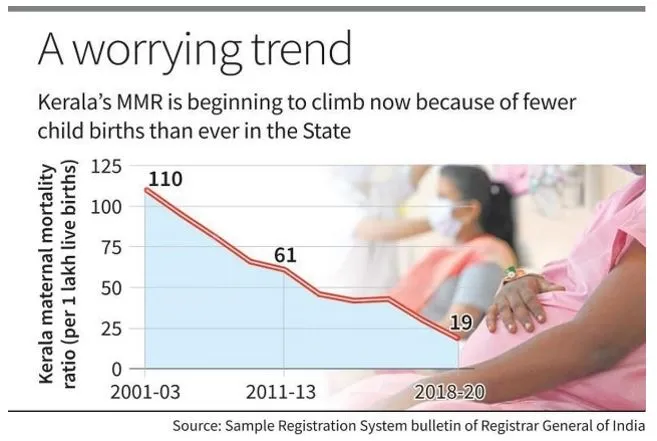

13th January 2025 (11 Topics)
Context
Kerala's maternal mortality ratio (MMR) is the lowest in India, standing at 19 maternal deaths per one lakh live births. However, this figure has been steadily increasing. Interestingly, this rise in MMR is not due to an increase in maternal deaths but rather because the number of live births in the state has significantly decreased. The state's fertility rate has dropped, leading to fewer births, which in turn raises the MMR when calculated per 100,000 births.
Key points:
- Decline in Births: Kerala used to have 5 to 5.5 lakh live births annually. The most recent data shows a sharp decline, with only about 3.93 lakh births recorded. This drop in the total number of births (denominator) makes the MMR appear higher, even though the actual number of maternal deaths has not increased significantly.
- MMR Calculation:
- Kerala's MMR is calculated based on both sample surveys (e.g., the Sample Registration System or SRS) and actual estimates from the Health Department. According to the SRS, Kerala’s MMR is 19, but the Health Department’s estimate puts it higher, around 29.
- The state had initially aimed for an MMR of 20 by 2030, but the decreasing number of births means that target is unlikely to be achieved. The MMR in 2024-25 may have already risen to 32.
- Fertility Rate and Demographic Changes:
- Kerala’s fertility rate has been steadily declining for years. In 1987-88, it achieved a replacement level fertility rate (2.1 children per woman), meaning the population could be maintained. However, the rate fell below 2.1 in 1991 and has hovered around 1.7-1.8 children per woman for years. In 2020, the fertility rate reached 1.5, and it could drop further to 1.35.
- The state’s population is aging, and there are fewer young people having children, largely due to migration (many young adults leave for education and jobs abroad), changing attitudes towards marriage and childbirth, and economic factors.
Reasons behind the fall in the fertility rate
- Delayed marriages:The increasing age at marriage and delayed childbearing also contribute to the problem. Many women are either choosing not to marry or have children, or are having children later in life, which affects fertility.
- Women’s workforce participation: An increase in female literacy and women’s workforce participation leads to busy lifestyles in urban areas and high stress jobs. It leads people to not consider having children at all.
- Other factors: The decline in fertility rates is also influenced by factors such as extreme shifts in the global distribution of live births due to:
- improved female education
- increasing usage of modern contraception methods
Impact of Low Fertility:
- Social and economic challenges: Low fertility rates are part of a broader trend where fewer children are born, impacting the state's demographics. As a result, Kerala is facing a shrinking younger population, and in the next 10 years, the elderly population will outnumber children.
- Labour Shortage Concerns:The fear of a looming labour shortage due to declining fertility rates is unlikely to materialize in the near future, as the total fertility rate in many states is stabilizing above replacement levels.
- Labour Mobility and Skills Development:Instead of focusing on population growth, addressing labour shortages can be achieved through improved mobility, skill development, and reducing state-imposed barriers on interstate migration.
- Women in the Labour Market:Despite improvements, India's work participation rate for women remains low compared to other developing economies, and demographic changes present an opportunity to improve women’s skills and integrate them into the labour force.
- Challenges for the Elderly:The rising number of elderly workers poses a challenge to the labour market. While many elderly individuals continue working due to household survival needs, the focus should be on relieving them from strenuous work and providing suitable employment.
Total Fertility Rate (TFR)
|
PYQQ. The total fertility rate in an economy is defined as: (UPSC 2024)
Solution: (d) Q2: Consider the following statement. (UPSC 2016)
Which one of the following conclusions may be true in the light of the above facts?
Solution: (d) |
More Articles


